Invest confidently in real estate
Invest confidently in real estate

Warren Buffett, one of the wealthiest people in the world, is famously quoted as saying, “If you don’t find a way to make money while you sleep, you will work until you die.” While few can expect to become a Buffett-level billionaire, earning passive income—making money while you sleep—is absolutely an attainable goal for smart investors.
The term “passive income” makes it sound like it’s easy money, but we all know that get rich quick schemes are to be avoided. The truth is that earning passive income is a long-term project, one that requires a commitment of time and money at the outset, and no shortage of work to get started.
Earning money from rental income through an investment property can be an incredibly lucrative passive income stream—the main question is how soon that income will be greater than your expenses. But before we dive into how to turn real estate into passive income, let’s start with some definitions.
When you are looking for ways to earn income beyond simply earning income from a job, there are two main categories: Portfolio income and Passive income. We’ll start by looking at the difference between portfolio income and passive income.
Portfolio income generally refers to income generated through investments like stocks or mutual funds. Some stocks in your portfolio may pay a dividend, which you might think of as passive income. In a sense it is, since you aren’t actively working to earn that money.
Passive income, academically, is anything you earn without doing some sort of active work. This isn’t to say that there’s no work involved, though.
An author, for instance, writes a book once and can earn money from the sale of it for the rest of their life—and beyond. There’s a significant amount of work that goes into creating the book in the first place, yes, but once that book is finished the author doesn’t need to write that book again in order to earn income from it.
Receiving passive income from real estate also requires up-front work, but income received from rent of a property will come without the same hourly-work commitment of earning a wage. Let’s look further at how to know if a property will really deliver the passive income you want.
A rental property is a long-term real estate investment that can generate passive income. You can earn rental income for as long as you own it. Many real estate investors endeavor to acquire several such properties to increase their monthly rent income, while others seek out multifamily properties to maximize their rental income. This rental income is passive income from the real estate investments.
One of the main things to consider before investing in a rental property is when the income you’re getting from rent will exceed expenses. You’ll want to consider the full range of expenses on a rental property before you can understand if you’ll be earning a profit from the passive income.
When a property is acquired, you’ll need to evaluate any repair or improvement costs needed to bring the property into a condition that will earn the kind of rent that you seek for the available units. Subsequently, there are operating costs like taxes, insurance, and utilities that will need to be paid. You will also need to account for any financing payments.
Assuming you want more than an “educated guess” of the potential for profit in your rental property (and you do), there is a fair amount of research that can go into answering that question—and that’s where Padvest comes in.
Padvest significantly speeds up the process of determining when a potential investment property will generate positive cash flow for that passive income. Our property evaluation report aggregate all the information from multiple sources and present it in an easy-to-read (and easy to customize) summary. It will provide the key essential metrics you will want to consider about that property.

Simply enter a street address and answer a few questions and Padvest quickly gathers all the relevant information about a property—including calculating your estimated repair & improvement costs and the full set of monthly expenses.
The report has a cash flow chart so you can immediately see when you’ll have earned back any initial costs incurred for repairs & improvements, and reach a point where the passive income will exceed regular expenses.
The numbers you see aren’t set in stone—many of the fields can be customized. If, for instance, you know you’ll have a bigger down payment or can get a lower interest rate, you can modify those fields and see an updated cash flow chart instantly. If you know you’ll charge more or less in monthly rent, changing those figures updates the report, too.
You’ll be able to analyze and evaluate the property to determine whether it’s a good investment for you, and project exactly when that property will become profitable. Previous property searches are saved automatically for you, as well, making it easier to compare multiple properties quickly.
Time is money, after all, so Padvest would like to help you shave your decision-making time from hours to minutes.